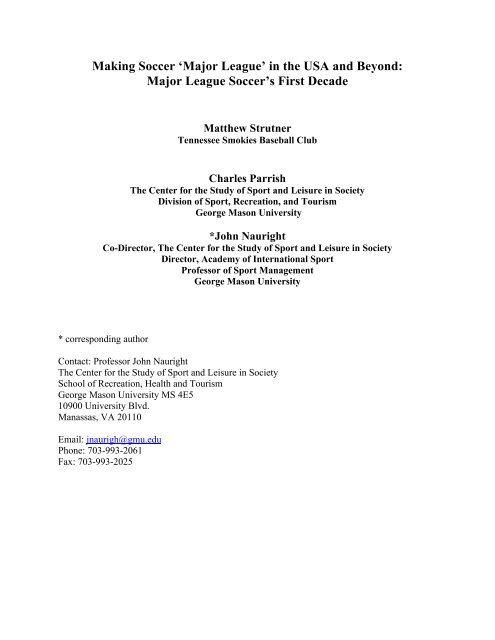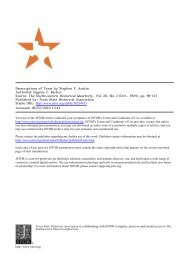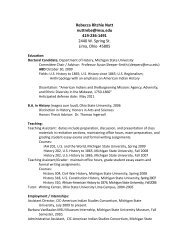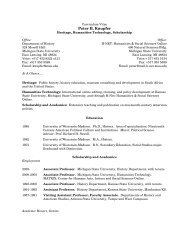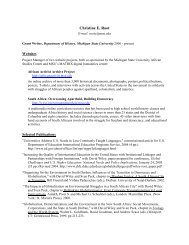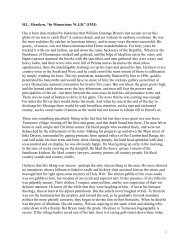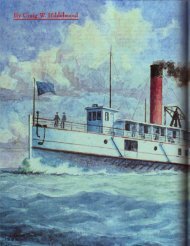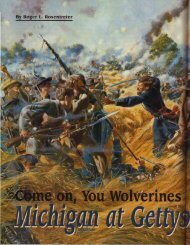'Major League' in the USA and Beyond - MSU Dept of History
'Major League' in the USA and Beyond - MSU Dept of History
'Major League' in the USA and Beyond - MSU Dept of History
You also want an ePaper? Increase the reach of your titles
YUMPU automatically turns print PDFs into web optimized ePapers that Google loves.
Mak<strong>in</strong>g Soccer ‘Major League’ <strong>in</strong> <strong>the</strong> <strong>USA</strong> <strong>and</strong> <strong>Beyond</strong>:<br />
Major League Soccer’s First Decade<br />
Mat<strong>the</strong>w Strutner<br />
Tennessee Smokies Baseball Club<br />
Charles Parrish<br />
The Center for <strong>the</strong> Study <strong>of</strong> Sport <strong>and</strong> Leisure <strong>in</strong> Society<br />
Division <strong>of</strong> Sport, Recreation, <strong>and</strong> Tourism<br />
George Mason University<br />
*John Nauright<br />
Co-Director, The Center for <strong>the</strong> Study <strong>of</strong> Sport <strong>and</strong> Leisure <strong>in</strong> Society<br />
Director, Academy <strong>of</strong> International Sport<br />
Pr<strong>of</strong>essor <strong>of</strong> Sport Management<br />
George Mason University<br />
* correspond<strong>in</strong>g author<br />
Contact: Pr<strong>of</strong>essor John Nauright<br />
The Center for <strong>the</strong> Study <strong>of</strong> Sport <strong>and</strong> Leisure <strong>in</strong> Society<br />
School <strong>of</strong> Recreation, Health <strong>and</strong> Tourism<br />
George Mason University MS 4E5<br />
10900 University Blvd.<br />
Manassas, VA 20110<br />
Email: jnaurigh@gmu.edu<br />
Phone: 703-993-2061<br />
Fax: 703-993-2025
2<br />
Mak<strong>in</strong>g Soccer ‘Major League’ <strong>in</strong> <strong>the</strong> <strong>USA</strong> <strong>and</strong> <strong>Beyond</strong>:<br />
Major League Soccer’s First Decade<br />
INTRODUCTION<br />
By 2006, follow<strong>in</strong>g its first decade, Major League Soccer (MLS) appeared to have<br />
proven American skeptics wrong about <strong>the</strong> potential for success <strong>and</strong> <strong>the</strong> likely fate <strong>of</strong> <strong>the</strong> league.<br />
Success, however, is very much a relative term. One must concede that MLS has helped br<strong>in</strong>g<br />
pr<strong>of</strong>essional soccer attention <strong>in</strong> <strong>the</strong> United States, played a role <strong>in</strong> <strong>the</strong> growth <strong>of</strong> <strong>the</strong> sport among<br />
America’s youth <strong>and</strong> experienced significant progress as a league s<strong>in</strong>ce its <strong>in</strong>augural season <strong>of</strong><br />
1996. However, <strong>the</strong> deficiencies <strong>of</strong> MLS were its struggle to compete nationally with <strong>the</strong> Big<br />
Four North American sports <strong>of</strong> baseball, American football, basketball <strong>and</strong> ice hockey, <strong>and</strong> its<br />
<strong>in</strong>ability to conv<strong>in</strong>ce <strong>the</strong> rest <strong>of</strong> <strong>the</strong> world that it <strong>of</strong>fers a comparable, first-class br<strong>and</strong> <strong>of</strong><br />
“football,” when measured aga<strong>in</strong>st <strong>the</strong> “Big 5” European leagues. Despite its recent strategies,<br />
which <strong>in</strong>clude lur<strong>in</strong>g <strong>in</strong>ternational premier players to <strong>the</strong> <strong>USA</strong> as well as <strong>the</strong> development <strong>of</strong><br />
<strong>in</strong>timate soccer specific stadiums, MLS cont<strong>in</strong>ues to be stigmatized as be<strong>in</strong>g <strong>in</strong>ferior to <strong>the</strong> o<strong>the</strong>r<br />
major pr<strong>of</strong>essional sport leagues <strong>in</strong> <strong>the</strong> United States as well as <strong>the</strong> high pr<strong>of</strong>ile soccer leagues <strong>of</strong><br />
Europe.<br />
Many Europeans equate MLS to its U.S. predecessor, <strong>the</strong> North American Soccer League<br />
(NASL), <strong>and</strong> it is <strong>of</strong>ten referred to as a “retirement league”, known for attract<strong>in</strong>g famous foreign<br />
players whose best play<strong>in</strong>g days have passed by <strong>of</strong>fer<strong>in</strong>g easy money. Early <strong>in</strong> <strong>the</strong> league’s<br />
existence, MLS experimented with this strategy <strong>and</strong> <strong>the</strong>n opted to pursue mostly young prospects<br />
from <strong>the</strong> CONCACAF region after <strong>the</strong> ‘hyped’ veteran players failed to live up to <strong>the</strong> promotion<br />
<strong>of</strong> <strong>the</strong>ir arrival (“Major League Soccer,” 2004). While <strong>the</strong> adoption <strong>of</strong> <strong>the</strong> “Beckham Rule” <strong>in</strong><br />
2007 rek<strong>in</strong>dled this strategy (Wahl, 2009), MLS still draws <strong>the</strong> vast majority its players from<br />
North, Central <strong>and</strong> South America. Unfortunately, negative connotations followed MLS to many<br />
parts <strong>of</strong> <strong>the</strong> globe, particularly <strong>in</strong> comparison to four <strong>of</strong> <strong>the</strong> most renowned pr<strong>of</strong>essional soccer<br />
leagues <strong>in</strong> existence: <strong>the</strong> English Premier League, <strong>the</strong> German Bundesliga, Spa<strong>in</strong>’s La Liga, <strong>and</strong><br />
Italy’s Lega Nazionale Pr<strong>of</strong>essionisti. Even <strong>the</strong> lead<strong>in</strong>g American players <strong>of</strong> <strong>the</strong> early <strong>and</strong> mid<br />
2000s, <strong>in</strong>clud<strong>in</strong>g Freddie Adu, Tim Howard, <strong>and</strong> DeMarcus Beasley, left MLS to pursue what<br />
were perceived to be better f<strong>in</strong>ancial <strong>and</strong> developmental opportunities <strong>in</strong> Europe, jo<strong>in</strong><strong>in</strong>g o<strong>the</strong>r<br />
American players already ply<strong>in</strong>g <strong>the</strong>ir trade across <strong>the</strong> Cont<strong>in</strong>ent.<br />
The flight <strong>of</strong> young talent from MLS mirrored <strong>the</strong> situation <strong>of</strong> <strong>the</strong> domestically successful<br />
Dutch <strong>and</strong> Belgian clubs who have failed to market <strong>the</strong>mselves <strong>in</strong> <strong>the</strong> <strong>in</strong>ternational market,<br />
missed out on star players, <strong>and</strong> <strong>the</strong>refore have been unable to raise <strong>the</strong>ir leagues to <strong>the</strong> level <strong>of</strong><br />
<strong>in</strong>ternational prestige that <strong>the</strong> top leagues enjoy. Ajax may be <strong>the</strong> most recognizable club <strong>in</strong> <strong>the</strong><br />
Dutch league but due to a lack <strong>of</strong> star power on its roster, <strong>in</strong>vestors have not been <strong>in</strong>terested <strong>in</strong> a<br />
venture that would create revenue <strong>and</strong> advance <strong>the</strong> team globally. As a result, Ajax rema<strong>in</strong>s<br />
competitively <strong>and</strong> f<strong>in</strong>ancially <strong>in</strong>ferior to <strong>the</strong> elite clubs <strong>of</strong> Engl<strong>and</strong>, Germany, Spa<strong>in</strong>, <strong>and</strong> Italy<br />
(“Football frenzy,” 2004). In its first decade <strong>of</strong> operation, MLS was faced with a similar scenario<br />
<strong>in</strong> which it needed to procure some <strong>of</strong> <strong>the</strong> world’s best players while <strong>the</strong>y were still <strong>in</strong> <strong>the</strong>ir<br />
prime—not veterans near<strong>in</strong>g retirement—<strong>in</strong> order to capitalize on <strong>the</strong> publicity <strong>and</strong> <strong>the</strong> <strong>in</strong>terested<br />
<strong>in</strong>vestors that were likely to follow. Fur<strong>the</strong>r, <strong>the</strong> key for <strong>the</strong> league was to devise a strategy to do<br />
this while reta<strong>in</strong><strong>in</strong>g <strong>the</strong> best domestic talent (Davis, 2007).
ESTABLISHING A PLAN FOR STABILITY AND GROWTH<br />
Throughout this first decade, MLS faced a number <strong>of</strong> obstacles on American soil. These<br />
<strong>in</strong>cluded acquir<strong>in</strong>g <strong>the</strong> services <strong>of</strong> passionate <strong>and</strong> motivated <strong>in</strong>vestors, reach<strong>in</strong>g out to a more<br />
ethnically diverse market, <strong>and</strong> emphasiz<strong>in</strong>g that soccer has <strong>the</strong> largest follow<strong>in</strong>g <strong>of</strong> any sport <strong>in</strong><br />
<strong>the</strong> world (“MLS commissioner Don Garber,” 2001). Tak<strong>in</strong>g <strong>in</strong>to account <strong>the</strong> unique <strong>in</strong>tricacies<br />
<strong>of</strong> MLS <strong>and</strong> its need to avoid <strong>the</strong> errors <strong>of</strong> <strong>the</strong> defunct North American Soccer League, <strong>the</strong><br />
league adopted a more globalized approach to its pr<strong>of</strong>essional soccer structure by establish<strong>in</strong>g<br />
<strong>the</strong> Project-40 player development program. MLS hoped this program would develop a deeper<br />
pool <strong>of</strong> players with which it could draw talent from to help <strong>in</strong>crease <strong>the</strong> level <strong>of</strong> play <strong>and</strong><br />
improve <strong>the</strong> league’s image <strong>and</strong> appeal for <strong>in</strong>vestors both nationally <strong>and</strong> <strong>in</strong>ternationally<br />
(Markovits & Hellerman, 2001).<br />
With respect to its market<strong>in</strong>g strategy, MLS focused on four primary <strong>in</strong>terests: <strong>the</strong><br />
construction <strong>of</strong> soccer-specific stadiums, cater<strong>in</strong>g to <strong>the</strong> Hispanic population, encourag<strong>in</strong>g <strong>the</strong><br />
youth <strong>of</strong> America to become spectators <strong>of</strong> <strong>the</strong> sport as well as participants, <strong>and</strong> <strong>the</strong> recruitment <strong>of</strong><br />
new <strong>in</strong>vestors to <strong>the</strong> league. Secondary considerations related to <strong>in</strong>creas<strong>in</strong>g sponsorship, <strong>the</strong><br />
establishment <strong>of</strong> team rivalries, league expansion, <strong>the</strong> <strong>in</strong>clusion <strong>of</strong> a healthy mix <strong>of</strong> domestic <strong>and</strong><br />
foreign players, chang<strong>in</strong>g <strong>and</strong> or develop<strong>in</strong>g team identities to resonate with fans, participation <strong>in</strong><br />
national <strong>and</strong> <strong>in</strong>ternational tournaments, <strong>and</strong> <strong>the</strong> host<strong>in</strong>g <strong>of</strong> <strong>in</strong>ternational exhibitions.<br />
It is apparent MLS also explored adopt<strong>in</strong>g or modify<strong>in</strong>g several <strong>of</strong> <strong>the</strong> techniques that<br />
bolstered <strong>the</strong> reputations <strong>of</strong> pr<strong>of</strong>essional leagues overseas <strong>and</strong> highlighted <strong>the</strong> global charm <strong>of</strong><br />
some <strong>of</strong> <strong>the</strong>ir clubs. Primarily, <strong>the</strong> placement strategies <strong>and</strong> market<strong>in</strong>g models used by <strong>the</strong><br />
thriv<strong>in</strong>g English, German, Spanish, <strong>and</strong> Italian soccer leagues differed from those be<strong>in</strong>g used <strong>in</strong><br />
<strong>the</strong> U.S <strong>and</strong> had a track record <strong>of</strong> success. Specifically, <strong>the</strong>se leagues <strong>and</strong> <strong>the</strong>ir lead<strong>in</strong>g clubs<br />
efficiently <strong>and</strong> successfully tapped <strong>in</strong>to foreign markets (<strong>in</strong>clud<strong>in</strong>g Asia <strong>and</strong> <strong>the</strong> sizable U.S.<br />
market), established strategic alliances with global media outlets (i.e. media mogul Rupert<br />
Murdoch) to generate revenue <strong>and</strong> enter <strong>the</strong> global arena, <strong>and</strong> sold clubs as popular <strong>in</strong>ternational<br />
br<strong>and</strong>s with appeal<strong>in</strong>g identities. Also, <strong>the</strong> creation <strong>and</strong> development <strong>of</strong> <strong>the</strong> Champions League<br />
tournament permitted fur<strong>the</strong>r global promotion through which <strong>the</strong> top four pr<strong>of</strong>essional soccer<br />
leagues <strong>and</strong> <strong>the</strong>ir member clubs were able to ma<strong>in</strong>ta<strong>in</strong> or improve upon <strong>the</strong>ir status. After a<br />
decade <strong>in</strong> existence, MLS appeared to have appropriated some <strong>of</strong> <strong>the</strong>se strategies. Clubs were<br />
compet<strong>in</strong>g <strong>in</strong> CONCACAF’s “Champions League”, work<strong>in</strong>g to develop recognizable br<strong>and</strong>s <strong>and</strong><br />
identities, secur<strong>in</strong>g media contracts with major television networks, <strong>and</strong> promot<strong>in</strong>g its br<strong>and</strong><br />
abroad (specifically through <strong>the</strong> <strong>in</strong>clusion <strong>of</strong> Chivas <strong>USA</strong> <strong>in</strong>to <strong>the</strong> league <strong>in</strong> 2005 <strong>and</strong> award<strong>in</strong>g<br />
an expansion franchise to Toronto, Canada).<br />
In order to underst<strong>and</strong> why Major League Soccer employed certa<strong>in</strong> market<strong>in</strong>g <strong>and</strong><br />
br<strong>and</strong><strong>in</strong>g techniques <strong>in</strong> its first ten years, one must first possess a basic knowledge <strong>of</strong> <strong>the</strong> history<br />
<strong>and</strong> structure <strong>of</strong> <strong>the</strong> league <strong>and</strong> <strong>the</strong> ways <strong>in</strong> which <strong>the</strong> American soccer system deviates from<br />
those known to Europe <strong>and</strong> <strong>the</strong> United K<strong>in</strong>gdom. The precursor to MLS was <strong>the</strong> North<br />
American Soccer League (NASL), a top pr<strong>of</strong>essional league that folded <strong>in</strong> 1984. In addition to<br />
decl<strong>in</strong><strong>in</strong>g attendance figures <strong>and</strong> gate receipts, rapid franchise expansion, <strong>the</strong> absence <strong>of</strong> a salary<br />
cap, <strong>in</strong>consistent media exposure, <strong>and</strong> <strong>the</strong> overwhelm<strong>in</strong>g presence <strong>of</strong> <strong>the</strong> New York Cosmos<br />
contributed to <strong>the</strong> demise <strong>of</strong> <strong>the</strong> league (Parrish, 2012). There was much to learn from <strong>the</strong> NASL<br />
<strong>in</strong> terms <strong>of</strong> what not to do, <strong>and</strong> MLS began by differentiat<strong>in</strong>g itself from <strong>the</strong> outset. One key<br />
difference between <strong>the</strong> NASL <strong>and</strong> MLS is <strong>the</strong> latter’s adoption <strong>of</strong> a s<strong>in</strong>gle entity structure. In<br />
contrast to most o<strong>the</strong>r pr<strong>of</strong>essional leagues, MLS contracts directly with <strong>the</strong> players <strong>in</strong> an attempt<br />
to ma<strong>in</strong>ta<strong>in</strong> control over spend<strong>in</strong>g, <strong>the</strong> cost <strong>of</strong> labor, facilitate an equitable revenue shar<strong>in</strong>g<br />
3
4<br />
relationship among clubs, <strong>and</strong> uniformly promote competitive balance (Dure, 2010; Wahl, 2009).<br />
Although this strategy has been controversial <strong>and</strong> resulted <strong>in</strong> a lawsuit by <strong>the</strong> player’s union<br />
(S<strong>in</strong>gh, 1999), it did achieve its objective. With respect to ownership, MLS owner-<strong>in</strong>vestors play<br />
more <strong>of</strong> a participatory role <strong>in</strong> operations than <strong>the</strong> typical pr<strong>of</strong>essional sport franchise owner, <strong>and</strong><br />
each benefits from <strong>the</strong> success <strong>of</strong> competitors. The league <strong>and</strong> its teams share revenues from <strong>the</strong><br />
gate, <strong>and</strong> while <strong>the</strong> league covers <strong>the</strong> cost <strong>of</strong> player salaries, travel, <strong>and</strong> half <strong>the</strong> cost <strong>of</strong> runn<strong>in</strong>g<br />
or rent<strong>in</strong>g each stadium, each club is responsible for <strong>the</strong> salaries <strong>of</strong> coaches <strong>and</strong> <strong>of</strong>fice staff, as<br />
well as costs associated with market<strong>in</strong>g <strong>and</strong> promotion (Cohn, 1999). While <strong>the</strong> NASL<br />
ultimately collapsed it brought <strong>the</strong> sport <strong>of</strong> soccer <strong>in</strong>to American consciousness, as evidenced by<br />
<strong>the</strong> <strong>in</strong>creased numbers <strong>of</strong> children <strong>and</strong> women who felt motivated to take up soccer <strong>in</strong> <strong>the</strong> 1970s<br />
<strong>and</strong> 1980s (Markovits & Hellerman, 2001). With this foundation laid, MLS adm<strong>in</strong>istrators were<br />
keen to capitalize on <strong>the</strong> consumer <strong>in</strong>terest that existed follow<strong>in</strong>g <strong>the</strong> 1994 FIFA World Cup held<br />
<strong>in</strong> <strong>the</strong> United States.<br />
INFRASTRUCTURAL DEVELOPMENTS<br />
Between 1996 <strong>and</strong> 2006, two reform movements with<strong>in</strong> <strong>the</strong> American soccer l<strong>and</strong>scape<br />
occurred <strong>and</strong> <strong>the</strong>se helped MLS improve its global image. One <strong>in</strong>volved <strong>the</strong> emergence <strong>of</strong> three<br />
dist<strong>in</strong>ct pr<strong>of</strong>essional leagues <strong>and</strong> one amateur league. This development created a type <strong>of</strong> farm<br />
league system, whereby an MLS team <strong>and</strong> <strong>the</strong>ir A-League affiliate team could vertically<br />
exchange players. By contrast, most European <strong>and</strong> Lat<strong>in</strong> American pr<strong>of</strong>essional leagues operate<br />
under a system <strong>of</strong> promotion <strong>and</strong> relegation, which <strong>in</strong>fluences <strong>the</strong> competitive fate <strong>of</strong> entire<br />
teams ra<strong>the</strong>r than mere <strong>in</strong>dividuals (Markovits & Hellerman, 2001). Specifically, <strong>the</strong> promotion<br />
<strong>and</strong> relegation format calls for <strong>the</strong> strongest teams from a lower league to switch places with <strong>the</strong><br />
weakest teams from a superior league. The American system <strong>and</strong> <strong>the</strong> promotion <strong>and</strong> relegation<br />
system differ significantly. The American system is a much more stable environment for<br />
franchises situated <strong>in</strong> <strong>the</strong> top league (MLS) <strong>and</strong> this appealed to <strong>in</strong>vestors given <strong>the</strong> risk <strong>of</strong><br />
performance based relegation was elim<strong>in</strong>ated. Fur<strong>the</strong>r, this framework established a preferential<br />
labor exchange system <strong>in</strong> which MLS teams were <strong>the</strong> procurers <strong>of</strong> talent ra<strong>the</strong>r than developers<br />
<strong>in</strong> comparison to <strong>the</strong> teams compet<strong>in</strong>g <strong>in</strong> <strong>the</strong> lower leagues. In summary, <strong>the</strong> emergence <strong>of</strong><br />
additional leagues served to develop additional talent beyond <strong>the</strong> rosters <strong>of</strong> MLS teams, expense<br />
free, for MLS <strong>in</strong>vestors.<br />
The second movement, called <strong>the</strong> Project-40 program, is a product <strong>of</strong> MLS’s partnership<br />
with U.S. Soccer <strong>and</strong> Nike. Accord<strong>in</strong>g to MLS commissioner Don Garber, this jo<strong>in</strong>t venture<br />
“creates promise for future American players participat<strong>in</strong>g <strong>in</strong> <strong>in</strong>ternational competitions” (MLS<br />
State <strong>of</strong> <strong>the</strong> Union Address, 2001). Specifically, Project-40 was a development program for<br />
college players ages 18-22 that <strong>in</strong>tended to showcase <strong>and</strong> enhance <strong>the</strong>ir skills <strong>in</strong> an effort to<br />
develop <strong>the</strong>se participants <strong>in</strong>to world-class competitors. The program also covered <strong>the</strong>ir college<br />
tuition <strong>and</strong> paid <strong>the</strong>m <strong>the</strong> m<strong>in</strong>imum MLS salary at <strong>the</strong> time. Project-40 recruited new talent from<br />
grassroots soccer organizations for MLS <strong>in</strong> an effort to improve <strong>the</strong> league <strong>and</strong> to enhance <strong>the</strong><br />
performance <strong>of</strong> <strong>the</strong> U.S. national team (Markovits & Hellerman, 2001).<br />
In addition to <strong>the</strong>se two <strong>in</strong>frastructural developments <strong>and</strong> <strong>the</strong> aforementioned bus<strong>in</strong>ess<br />
market<strong>in</strong>g <strong>in</strong>itiatives, MLS embarked on a strategy to f<strong>in</strong>ance <strong>and</strong> construct soccer specific<br />
stadiums early <strong>in</strong> <strong>the</strong> league’s existence. Many thought this to be an important step to promote<br />
<strong>the</strong> sport to an American <strong>and</strong> global audience skeptical <strong>and</strong> critical <strong>of</strong> a league play<strong>in</strong>g games <strong>in</strong><br />
stadiums hold<strong>in</strong>g 70,000 fans or more <strong>and</strong> on fields designed <strong>and</strong> marked for gridiron football<br />
(Dure, 2010). In 1999, Columbus Crew Stadium <strong>in</strong> Columbus, Ohio opened as <strong>the</strong> first major
5<br />
stadium <strong>in</strong> <strong>the</strong> U.S. built specifically for soccer. Longtime soccer pioneer Lamar Hunt - owner <strong>of</strong><br />
<strong>the</strong> Crew, <strong>the</strong> Kansas City Wizards, <strong>and</strong> <strong>the</strong> National Football League’s Kansas City Chiefs -<br />
funded <strong>the</strong> $28.5 million, 22,500-seat facility. The stadium automatically impacted <strong>the</strong> team <strong>and</strong><br />
<strong>the</strong> league. Average attendance <strong>in</strong> <strong>the</strong> MLS <strong>in</strong>creased between 1998 <strong>and</strong> 1999, a direct result <strong>of</strong><br />
<strong>the</strong> Crew sell<strong>in</strong>g 9,000 season tickets <strong>and</strong> averag<strong>in</strong>g over 22,000 spectators for <strong>the</strong>ir stadium’s<br />
open<strong>in</strong>g season. Revenue came from sources beyond pay<strong>in</strong>g customers as eight new sponsors<br />
jo<strong>in</strong>ed <strong>the</strong> team as well that year (Cohn, 1999). Columbus was MLS’s smallest soccer market,<br />
but <strong>the</strong> presence <strong>of</strong> <strong>the</strong> stadium made <strong>the</strong> Crew <strong>the</strong> league leader <strong>in</strong> attendance <strong>in</strong> 1999 (Dure,<br />
2010). Crew Stadium featured a $1 million scoreboard, a ‘Wreck Room’ area for children, an<br />
8,000-square-foot video arcade, <strong>and</strong> a plaza for local b<strong>and</strong>s. Columbus president James Rootes<br />
commented on <strong>the</strong> importance <strong>of</strong> mak<strong>in</strong>g fans’ experience at <strong>the</strong> stadium as <strong>in</strong>teractive as<br />
possible, while <strong>the</strong> MLS market<strong>in</strong>g director po<strong>in</strong>ted out that Crew Stadium created an “electric<br />
atmosphere,” <strong>and</strong> that was someth<strong>in</strong>g additional sponsors would quickly latch on to as a way to<br />
most effectively place <strong>the</strong>ir own products (Cohn, 1999). Prior to 1999, <strong>the</strong> Crew played <strong>the</strong>ir<br />
games <strong>in</strong> <strong>the</strong> colossal Ohio Stadium, home <strong>of</strong> The Ohio State University Buckeyes football team<br />
which at <strong>the</strong> time seated well over 90,000. In fact, nearly every MLS team started out rent<strong>in</strong>g its<br />
stadium from a NFL or NCAA football team but follow<strong>in</strong>g <strong>the</strong> success <strong>of</strong> Crew Stadium <strong>the</strong><br />
trend began to change (Hopk<strong>in</strong>s, 2010). Prior to <strong>the</strong> open<strong>in</strong>g <strong>of</strong> <strong>the</strong> Home Depot Center <strong>in</strong> 2003,<br />
<strong>the</strong> L.A. Galaxy played at <strong>the</strong> Rose Bowl stadium (capacity over 100,000), <strong>the</strong> San Jose<br />
Earthquakes shared Spartan Stadium (later Buck Shaw Stadium) with San Jose State University,<br />
<strong>and</strong> Dallas <strong>in</strong>itially used <strong>the</strong> Cotton Bowl stadium. All <strong>of</strong> <strong>the</strong> rema<strong>in</strong><strong>in</strong>g league teams made use<br />
<strong>of</strong> NFL stadiums for <strong>the</strong>ir home fields, with <strong>the</strong> exception <strong>of</strong> <strong>the</strong> Miami Fusion who played <strong>in</strong> a<br />
converted high school football stadium (Cohn, 1999).<br />
There are several reasons why football stadiums are problemmatic for MLS teams. To<br />
beg<strong>in</strong>, <strong>the</strong> stadiums are costly to rent <strong>and</strong> <strong>the</strong> burden to cover <strong>the</strong> lease falls on <strong>the</strong> League<br />
(“Major League Soccer,” 2004). Secondly, football stadiums are much too large for a typical<br />
MLS crowd <strong>of</strong> around 15,000 fans. Play<strong>in</strong>g among this number <strong>of</strong> fans <strong>in</strong>side a cavernous<br />
stadium dim<strong>in</strong>ishes <strong>the</strong> atmosphere at games. O<strong>the</strong>r reasons football stadiums do not suffice<br />
<strong>in</strong>clude <strong>the</strong> fact that <strong>the</strong> fields are too narrow <strong>and</strong> short for soccer, <strong>and</strong> because adm<strong>in</strong>istrators,<br />
players, <strong>and</strong> fans lack a feel<strong>in</strong>g <strong>of</strong> <strong>in</strong>dependence <strong>and</strong> significance as a franchise when <strong>the</strong>y share<br />
ano<strong>the</strong>r team’s facility <strong>and</strong> have no site to call <strong>the</strong>ir own. Accord<strong>in</strong>g to Galaxy vice president <strong>and</strong><br />
general manager Doug Hamilton, <strong>the</strong>re was an added dimension to construct<strong>in</strong>g a soccer-specific<br />
stadium:<br />
It communicates to <strong>the</strong> bus<strong>in</strong>ess community <strong>and</strong> to <strong>the</strong> nation at large that soccer is a<br />
viable sports <strong>and</strong> bus<strong>in</strong>ess venture. When you’re rent<strong>in</strong>g, you pretty much can pack up<br />
<strong>and</strong> go anytime you want. When you <strong>in</strong>vest <strong>in</strong> brick <strong>and</strong> mortar <strong>and</strong> you’ve laid <strong>the</strong><br />
foundation, <strong>the</strong>re’s no place to run. That’s a bold statement (D’Hippolito, 2002, p. 1).<br />
In 2003, <strong>the</strong> Los Angeles Galaxy moved <strong>in</strong>to <strong>the</strong> Home Depot Center <strong>in</strong> nearby Carson,<br />
California. This venue was <strong>the</strong> second soccer specific stadium to host an MLS franchise <strong>and</strong> was<br />
<strong>the</strong> result <strong>of</strong> a $150 million dollar <strong>in</strong>vestment from ownership group AEG (Anschutz<br />
Enterta<strong>in</strong>ment Group). With seat<strong>in</strong>g for 27,000, <strong>the</strong> stadium is situated <strong>in</strong> <strong>the</strong> middle <strong>of</strong> an 85-<br />
acre complex that also <strong>in</strong>cludes facilities for track <strong>and</strong> tennis, seven soccer fields, <strong>and</strong> a threemile<br />
jogg<strong>in</strong>g path. The Home Depot Center was dubbed “<strong>the</strong> spiritual home <strong>of</strong> soccer <strong>in</strong> <strong>the</strong><br />
United States” by MLS Commissioner Don Garber. In 2005, <strong>the</strong> expansion CD Chivas <strong>USA</strong>
6<br />
team called <strong>the</strong> complex home <strong>and</strong> it now serves as <strong>the</strong> tra<strong>in</strong><strong>in</strong>g grounds for <strong>the</strong> U.S. National<br />
Team. The facility is <strong>of</strong>ten used for local youth cl<strong>in</strong>ics <strong>and</strong> academies <strong>in</strong> order to help peak <strong>the</strong>ir<br />
<strong>in</strong>terest <strong>in</strong> <strong>the</strong> team. With <strong>the</strong> open<strong>in</strong>g <strong>of</strong> this venue, <strong>the</strong> money <strong>the</strong> Galaxy previously spent<br />
tra<strong>in</strong><strong>in</strong>g overseas could now be diverted to participation <strong>in</strong> <strong>in</strong>ternational tours <strong>and</strong> tournaments as<br />
a result <strong>of</strong> sufficient local facilities. In fact, <strong>the</strong> team made its tra<strong>in</strong><strong>in</strong>g facilities available to both<br />
foreign clubs <strong>and</strong> national teams who are will<strong>in</strong>g to pay for use <strong>of</strong> <strong>the</strong> state-<strong>of</strong>-<strong>the</strong>-art amenities.<br />
In contrast to o<strong>the</strong>r MLS teams at <strong>the</strong> time, <strong>the</strong> L.A. Galaxy was able to <strong>of</strong>fer visitors <strong>and</strong> fans an<br />
<strong>in</strong>-stadium team store, a 450-seat restaurant, <strong>and</strong> 43 luxury boxes <strong>and</strong> <strong>the</strong>se additional revenue<br />
streams provided a boost to <strong>the</strong> team’s bottom l<strong>in</strong>e.<br />
A European-based design was used <strong>in</strong> <strong>the</strong> construction <strong>of</strong> <strong>the</strong>se new soccer-specific<br />
stadiums. St<strong>and</strong>s were constructed <strong>in</strong> rectangular configurations, not oval, <strong>and</strong> field level seats<br />
put spectators closer to <strong>the</strong> action. In addition, adm<strong>in</strong>istrators hoped that by hav<strong>in</strong>g a smaller<br />
seat<strong>in</strong>g capacity, an <strong>in</strong>crease <strong>in</strong> <strong>the</strong> dem<strong>and</strong> for tickets would have a positive impact on <strong>the</strong>ir<br />
market value (D’Hippolito, 2002). Additional soccer specific stadiums were constructed after<br />
Crew Stadium <strong>and</strong> <strong>the</strong> Home Depot Center. At <strong>the</strong> close <strong>of</strong> <strong>the</strong> first decade, two additional<br />
soccer specific stadiums were <strong>in</strong> use; FC Dallas moved <strong>in</strong>to “Pizza Hut Park” <strong>in</strong> 2005 <strong>and</strong> <strong>the</strong><br />
Chicago Fire relocated to “Toyota Park” <strong>in</strong> 2006. Also, additional stadiums were be<strong>in</strong>g<br />
constructed <strong>and</strong> or were <strong>in</strong> <strong>the</strong> plann<strong>in</strong>g stages, <strong>in</strong>clud<strong>in</strong>g <strong>the</strong> expansion Toronto FC’s BMO<br />
Field <strong>and</strong> Colorado’s Dick’s Sport<strong>in</strong>g Goods Park (Dure, 2010).<br />
However, not all clubs were eager to <strong>in</strong>vest <strong>in</strong> new stadiums. For example, <strong>the</strong> owners <strong>of</strong><br />
<strong>the</strong> New Engl<strong>and</strong> Revolution <strong>and</strong> Kansas City Wizards were happy to ma<strong>in</strong>ta<strong>in</strong> <strong>the</strong> use <strong>of</strong> <strong>the</strong>ir<br />
stadiums <strong>and</strong> this is not surpris<strong>in</strong>g given both teams were operated by <strong>in</strong>vestors who also owned<br />
<strong>the</strong> NFL teams <strong>in</strong> residence at <strong>the</strong>ir respective stadiums. This allowed both <strong>the</strong> Revolution <strong>and</strong><br />
Wizards to avoid stadium rental fees <strong>and</strong> <strong>the</strong> f<strong>in</strong>ancial burdens associated with construct<strong>in</strong>g <strong>and</strong><br />
operat<strong>in</strong>g an additional sports facility while also provid<strong>in</strong>g additional sport related revenue for<br />
<strong>the</strong> ownership groups. In this <strong>in</strong>stance, however, fans <strong>of</strong> both teams were left to deal with <strong>the</strong><br />
annoyance <strong>of</strong> visible football l<strong>in</strong>es on <strong>the</strong> field as well as <strong>in</strong>ferior sight l<strong>in</strong>es <strong>and</strong> a lack <strong>of</strong> an<br />
<strong>in</strong>timate atmosphere that accompanied home matches <strong>in</strong> <strong>the</strong>se venues.<br />
TARGETING DIVERSITY<br />
Midway through <strong>the</strong> first decade MLS def<strong>in</strong>ed <strong>the</strong> grow<strong>in</strong>g Hispanic community – which<br />
at <strong>the</strong> time comprised approximately 13 per cent <strong>of</strong> <strong>the</strong> U.S. population - as its most vital market<br />
segment. A number <strong>of</strong> MLS teams were located <strong>in</strong> cities with large Hispanic populations,<br />
<strong>in</strong>clud<strong>in</strong>g L.A., Chicago, <strong>and</strong> New York. Although several MLS teams have marketed to Lat<strong>in</strong>os<br />
from <strong>the</strong> beg<strong>in</strong>n<strong>in</strong>g, <strong>the</strong> idea did not become a league priority until 2001 (Stone, 2001). Up until<br />
this time, MLS concentrated its efforts on middle-class college students <strong>and</strong> potential wealthy<br />
<strong>in</strong>vestors. Its <strong>in</strong>itial strategy sought to place <strong>the</strong> new pr<strong>of</strong>essional soccer league <strong>in</strong> <strong>the</strong> middle <strong>of</strong><br />
<strong>the</strong> enterta<strong>in</strong>ment <strong>in</strong>dustry <strong>and</strong> Americanize <strong>the</strong> sport ra<strong>the</strong>r than try<strong>in</strong>g to ga<strong>in</strong> fans based upon<br />
<strong>the</strong> on-field performance <strong>of</strong> <strong>the</strong> players. Players <strong>and</strong> teams were given flashy nicknames such as<br />
Roy ‘Lights Out’ Lassiter <strong>and</strong> ‘The Wiz’ (Kansas City), <strong>and</strong> <strong>in</strong>stead <strong>of</strong> allow<strong>in</strong>g games to f<strong>in</strong>ish<br />
<strong>in</strong> a tie, MLS <strong>in</strong>stituted a shoot-out to satisfy American fans’ appetite for a w<strong>in</strong>ner <strong>of</strong> each match<br />
(Dure, 2010).<br />
Accord<strong>in</strong>g to a 2001 survey, however, 40 per cent <strong>of</strong> MLS fans came from Hispanic<br />
communities. The league f<strong>in</strong>ally realized that it was look<strong>in</strong>g <strong>in</strong> <strong>the</strong> wrong direction <strong>and</strong> too far<br />
<strong>in</strong>to <strong>the</strong> future, <strong>and</strong> determ<strong>in</strong>ed that it must first start cater<strong>in</strong>g to its core base <strong>of</strong> Hispanic fans.<br />
MLS began push<strong>in</strong>g its product with <strong>the</strong> slogan, ‘It’s Your Game,’ imply<strong>in</strong>g that <strong>the</strong> league was
7<br />
giv<strong>in</strong>g <strong>the</strong> game back to Lat<strong>in</strong> Americans <strong>in</strong> a form that <strong>the</strong>y could respect. By 2006, Hispanic<br />
Heritage Nights were commonplace at stadiums throughout <strong>the</strong> league. The aforementioned<br />
amended ‘tie breaker shoot-out’ was also elim<strong>in</strong>ated <strong>and</strong> <strong>the</strong> typical extra time format followed<br />
games that ended <strong>in</strong> a draw. Even after <strong>the</strong> changes, <strong>the</strong> targeted population cont<strong>in</strong>ued to be a<br />
difficult segment to attract because <strong>the</strong>se consumers found it hard to identify with <strong>the</strong> MLS clubs<br />
<strong>and</strong> <strong>the</strong> American football stadiums <strong>in</strong> which <strong>the</strong>y played (Vickery, 2001).<br />
The Hispanic Heritage Nights were a more successful promotion. Each MLS team<br />
sponsored <strong>and</strong> operated its own pre-game festival, filled with Lat<strong>in</strong> enterta<strong>in</strong>ment, food,<br />
products, <strong>and</strong> most notably, <strong>the</strong> on-field recognition <strong>of</strong> 50 <strong>in</strong>dividuals from <strong>the</strong> Hispanic<br />
community who were named ‘Hispanic Heroes.’ Portions <strong>of</strong> <strong>the</strong> proceeds from <strong>the</strong>se nights were<br />
set aside to support <strong>the</strong> Hispanic Scholarship Fund. In select<strong>in</strong>g <strong>the</strong> heroes, MLS teams<br />
successfully immersed <strong>the</strong>mselves <strong>in</strong> a number <strong>of</strong> prom<strong>in</strong>ent Lat<strong>in</strong>o communities <strong>and</strong> this<br />
allowed <strong>the</strong> league <strong>and</strong> its teams to form mean<strong>in</strong>gful contacts <strong>and</strong> relationships while also<br />
express<strong>in</strong>g a clear desire to promote diversity <strong>in</strong> <strong>the</strong> league. Recogniz<strong>in</strong>g <strong>the</strong> large melt<strong>in</strong>g pot<br />
that <strong>the</strong> U.S. <strong>in</strong>creas<strong>in</strong>gly represented, MLS br<strong>and</strong>ed itself as ‘<strong>the</strong> League for <strong>the</strong> New America’<br />
<strong>in</strong> an effort to reach a fragmented domestic market (“About MLS,” 2004). Fur<strong>the</strong>r, <strong>the</strong> addition<br />
<strong>of</strong> CD Chivas <strong>USA</strong> <strong>in</strong> 2005 was a clear <strong>in</strong>dication that MLS stood firm with its commitment to<br />
<strong>in</strong>crease <strong>the</strong> presence <strong>of</strong> Hispanic fans by add<strong>in</strong>g a team with an identity that resonated among<br />
<strong>the</strong> many Mexican-Americans liv<strong>in</strong>g <strong>in</strong> <strong>the</strong> United States (Pierce, 2004).<br />
With respect to <strong>the</strong> market<strong>in</strong>g efforts <strong>of</strong> <strong>in</strong>dividual teams, D.C. United discounted match<br />
tickets <strong>and</strong> sold <strong>the</strong>m to Hispanic bus<strong>in</strong>esses that <strong>in</strong> turn dispersed <strong>the</strong>m at face value to <strong>the</strong>ir<br />
many regular customers (Stone, 2001). The Dallas Burn (now FC Dallas) targeted Hispanics<br />
beg<strong>in</strong>n<strong>in</strong>g <strong>in</strong> 1997, when it feared it would lose much <strong>of</strong> its fan base due to <strong>the</strong> departure <strong>of</strong> <strong>the</strong><br />
team’s biggest draw, Mexican star Hugo Sanchez. The team looked to focus its efforts on<br />
Hispanic immigrants, <strong>and</strong> hired a local Hispanic advertis<strong>in</strong>g agency to research <strong>the</strong> community<br />
<strong>and</strong> develop a promotional strategy for <strong>the</strong> club. ‘Vive La Pasion’ (Live <strong>the</strong> Passion) became <strong>the</strong><br />
club’s slogan, <strong>and</strong> <strong>the</strong> Dallas players took calls from listeners from <strong>the</strong> local Spanish-language<br />
radio stations, visited local schools, <strong>and</strong> attended community events. The club also discounted<br />
weeknight game tickets, used Hispanic media sponsors, <strong>and</strong> advertised upcom<strong>in</strong>g games <strong>in</strong><br />
Spanish-language newspapers <strong>and</strong> on Spanish-speak<strong>in</strong>g radio stations. Dallas’ home games were<br />
broadcast on <strong>the</strong>se local radio stations, while away games received coverage on Spanish<br />
television station Telemundo. F<strong>in</strong>ally, <strong>the</strong> team formed a relationship with a Hispanic adult<br />
amateur soccer league whose members agreed to purchase group tickets <strong>in</strong> exchange for use <strong>of</strong><br />
<strong>the</strong> Cotton Bowl for <strong>the</strong>ir league f<strong>in</strong>al, sold tickets through vendors <strong>in</strong> Hispanic neighborhoods,<br />
<strong>and</strong> hired more bil<strong>in</strong>gual employees to staff <strong>the</strong> team’s front <strong>of</strong>fice (Parker, 1999).<br />
DEVELOPING FUTURE CONSUMERS<br />
Along with <strong>the</strong> Hispanic community, MLS understood that America’s youth played a<br />
significant role <strong>in</strong> <strong>the</strong> popularity <strong>and</strong> future growth <strong>of</strong> <strong>the</strong> market <strong>and</strong> <strong>the</strong> league based much <strong>of</strong><br />
its bus<strong>in</strong>ess philosophy around this idea. In fact, appeal<strong>in</strong>g to this demographic constituted two<br />
<strong>of</strong> <strong>the</strong> league’s five guid<strong>in</strong>g pr<strong>in</strong>ciples for <strong>the</strong> future (“About MLS,” 2004). An estimated 18<br />
million children (high school age <strong>and</strong> under) participated <strong>in</strong> soccer <strong>in</strong> <strong>the</strong> United States at <strong>the</strong><br />
turn <strong>of</strong> <strong>the</strong> century yet <strong>the</strong> translatable number <strong>of</strong> participants to MLS spectators was very low<br />
(Cohn, 1999). A poll conducted by ESPN, however, revealed that MLS tied MLB as <strong>the</strong> third<br />
most popular pr<strong>of</strong>essional league among youth. Break<strong>in</strong>g <strong>in</strong>to <strong>the</strong> Big Three with children was<br />
viewed as a significant step for <strong>the</strong> league. In his 2001 State <strong>of</strong> <strong>the</strong> League address, MLS
8<br />
Commissioner Don Garber pr<strong>of</strong>essed that <strong>the</strong> <strong>in</strong>crease <strong>in</strong> season ticket sales was due to <strong>the</strong><br />
pressure children placed on <strong>the</strong>ir parents to take <strong>the</strong>m to games. By secur<strong>in</strong>g young talent, such<br />
as Bobby Convey <strong>and</strong> Freddy Adu, MLS made <strong>the</strong> sport more appeal<strong>in</strong>g to this demographic.<br />
Also, league adm<strong>in</strong>istrators understood that <strong>the</strong> youth demographic was becom<strong>in</strong>g <strong>in</strong>creas<strong>in</strong>gly<br />
technological <strong>and</strong> <strong>the</strong> Internet was identified as a necessary medium to communicate with <strong>the</strong><br />
younger generation. MLSnet.com was completely revamped <strong>and</strong> improved, with a Spanishlanguage<br />
component <strong>and</strong> video clips section added. The move spawned an immediate 60 per cent<br />
<strong>in</strong>crease <strong>in</strong> visitors to <strong>the</strong> site (“MLS commissioner Don Garber,” 2001).<br />
The league <strong>and</strong> <strong>in</strong>dividual clubs <strong>in</strong>corporated children whenever <strong>and</strong> wherever possible<br />
dur<strong>in</strong>g <strong>the</strong> first ten years. For example, <strong>the</strong> Rapids <strong>in</strong>troduced a Kids Club through which<br />
members received regular e-mail updates, discounts, <strong>and</strong> gifts, as well as an essay contest for<br />
club members. In addition, <strong>the</strong>y partnered with local YMCA’s to create a program called Junior<br />
Rapids. In New York, MetroStars team members <strong>of</strong>fered private tra<strong>in</strong><strong>in</strong>g sessions to youth teams<br />
based on age <strong>and</strong> skill level, complete with enough tickets for everyone to attend a MetroStars<br />
game. MLS teams also attempted to raise club awareness us<strong>in</strong>g vehicles that traveled around<br />
with <strong>in</strong>flatable games, appear<strong>in</strong>g at community programs, corporate events, <strong>and</strong> pre-game<br />
festivities. L.A.’s portable experience brought <strong>the</strong> team’s br<strong>and</strong> <strong>and</strong> promoted <strong>the</strong> game to<br />
children us<strong>in</strong>g <strong>the</strong> Galaxy Shuttle (“Galaxy Shuttle,” 2004). Chicago used its F.I.R.E. Express<br />
for <strong>the</strong> same purpose (“F.I.R.E. Express,” 2004).<br />
ATTRACTING INVESTORS & CORPORATE PARTNERS<br />
<strong>Beyond</strong> stadium construction, target market<strong>in</strong>g towards Hispanics, <strong>and</strong> transform<strong>in</strong>g <strong>the</strong><br />
nation’s young soccer participants <strong>in</strong>to consumers, <strong>the</strong> league understood that if it was go<strong>in</strong>g to<br />
grow its br<strong>and</strong> domestically <strong>and</strong> <strong>in</strong>ternationally attract<strong>in</strong>g new <strong>in</strong>vestors was <strong>of</strong> <strong>the</strong> utmost<br />
importance. A cohort <strong>of</strong> confident <strong>in</strong>vestors would reflect league stability <strong>and</strong> also represented<br />
<strong>the</strong> possibility to <strong>in</strong>troduce expansion clubs to new <strong>and</strong> previously untapped markets. However,<br />
over its first ten years MLS established a track record <strong>of</strong> los<strong>in</strong>g money (<strong>in</strong>clud<strong>in</strong>g $250 million<br />
over a 6 year span) <strong>and</strong> at one po<strong>in</strong>t <strong>in</strong> time experienced a three-year draught <strong>in</strong> terms <strong>of</strong><br />
recruit<strong>in</strong>g new <strong>in</strong>vestors (Dure, 2010). Contraction <strong>of</strong> <strong>the</strong> League follow<strong>in</strong>g <strong>the</strong> 2001 season, left<br />
seven <strong>of</strong> <strong>the</strong> league’s 10 rema<strong>in</strong><strong>in</strong>g teams <strong>in</strong> <strong>the</strong> h<strong>and</strong>s <strong>of</strong> just two <strong>in</strong>vestors: Philip Anshutz with<br />
five <strong>and</strong> Lamar Hunt with two (Dure, 2010). This underscored <strong>the</strong> urgent need to reduce <strong>the</strong><br />
f<strong>in</strong>ancial stra<strong>in</strong> <strong>and</strong> risk associated with <strong>in</strong>vest<strong>in</strong>g <strong>in</strong> MLS <strong>in</strong> order to attract <strong>in</strong>vestors to <strong>the</strong><br />
league. Besides hav<strong>in</strong>g dismal attendance records, Tampa Bay was dropped from <strong>the</strong> League<br />
because it could not f<strong>in</strong>d an <strong>in</strong>vestor, lay<strong>in</strong>g a heavy burden on MLS. Meanwhile, Miami’s<br />
<strong>in</strong>vestor walked away because his sponsors had ab<strong>and</strong>oned <strong>the</strong> team <strong>and</strong> <strong>the</strong> f<strong>in</strong>ancial<br />
commitment was too much (Lisi, 2002). Anshutz, a powerful bus<strong>in</strong>essman who has hold<strong>in</strong>gs <strong>in</strong><br />
oil, real estate, <strong>the</strong> nation’s largest movie <strong>the</strong>ater cha<strong>in</strong>, <strong>and</strong> a number <strong>of</strong> media properties <strong>in</strong><br />
addition to several MLS franchises, at one po<strong>in</strong>t was <strong>the</strong> pr<strong>in</strong>cipal <strong>in</strong>vestor for six teams but<br />
eventually sold his rights to D.C. United, New York MetroStars, Colorado Rapids, <strong>and</strong> <strong>the</strong><br />
Chicago Fire. While <strong>the</strong>se decisions to scale back <strong>in</strong>vestment may appear to be a negative<br />
development some thought it beneficial for <strong>the</strong> league over <strong>the</strong> long term. “Not that <strong>the</strong>y’re<br />
los<strong>in</strong>g <strong>in</strong>terest, but <strong>the</strong>y th<strong>in</strong>k that <strong>the</strong> competition is good. – It makes sense. You don’t want<br />
ownership <strong>of</strong> every team” (McGhee & Barba, 2004).<br />
<strong>Beyond</strong> <strong>the</strong> money supplied by <strong>in</strong>vestors, significant revenue was provided by sponsors<br />
<strong>and</strong> suppliers dur<strong>in</strong>g <strong>the</strong> League’s <strong>in</strong>fancy. MLS established long term relationships with more<br />
than twenty commercial organizations, <strong>in</strong>clud<strong>in</strong>g big name sponsors Honda, Budweiser, Yahoo!,
9<br />
<strong>and</strong> Aquaf<strong>in</strong>a <strong>and</strong> this served to promote <strong>the</strong> sport to a large nationwide audience <strong>and</strong> allowed<br />
<strong>the</strong> league to capitalize on <strong>the</strong> established br<strong>and</strong> image <strong>the</strong>se sponsors possessed. Corporate<br />
partnerships were also formed with Mardi Gras <strong>and</strong> Panasonic, both <strong>of</strong> which attract a specific<br />
group <strong>of</strong> target consumers <strong>the</strong> league sought to attract (“About MLS,” 2004).<br />
DEVELOPING RIVALRIES & IDENTITIES<br />
Also, MLS recognized it lacked rivalries. Although some tensions arose between San<br />
Jose <strong>and</strong> L.A. <strong>and</strong> <strong>the</strong>ir California Clasico, <strong>the</strong> league needed to develop its own version <strong>of</strong> <strong>the</strong><br />
Red Sox-Yankees clash to give fans an excit<strong>in</strong>g feud to anxiously anticipate. While one may<br />
argue significant rivalries existed prior to 2005, this year proved to be one <strong>in</strong> which several<br />
rivalries were constructed by <strong>the</strong> League. Chivas <strong>USA</strong> was <strong>in</strong>troduced as an expansion team <strong>in</strong><br />
Los Angeles <strong>and</strong> this created a natural geographically based rivalry with <strong>the</strong> L.A. Galaxy (Pierce,<br />
2004). With <strong>the</strong> teams exist<strong>in</strong>g <strong>in</strong> <strong>the</strong> same market <strong>and</strong> shar<strong>in</strong>g <strong>the</strong> same stadium (The Home<br />
Depot Center) <strong>the</strong> SuperClasico emerged as <strong>the</strong> foremost rivalry <strong>in</strong> MLS. Also, Real Salt Lake<br />
was added to <strong>the</strong> league <strong>in</strong> 2005 <strong>and</strong> this created a geographically based rivalry between Real<br />
<strong>and</strong> Colorado <strong>and</strong> <strong>the</strong> annual home <strong>and</strong> away match up was co<strong>in</strong>ed <strong>the</strong> Rocky Mounta<strong>in</strong> Cup.<br />
While o<strong>the</strong>r rivalries have certa<strong>in</strong>ly emerged after <strong>the</strong> league’s first decade <strong>the</strong> vast majority <strong>of</strong><br />
<strong>the</strong> rivalry cups were established dur<strong>in</strong>g <strong>the</strong> first decade <strong>and</strong> <strong>the</strong>se cont<strong>in</strong>ue to be significant<br />
fixtures on <strong>the</strong> MLS calendar.<br />
The Premier League, <strong>the</strong> Bundesliga, La Liga, <strong>and</strong> Lega Nazionale Pr<strong>of</strong>essionisti all have<br />
18-20 teams, whereas MLS ma<strong>in</strong>ta<strong>in</strong>ed a much smaller league <strong>in</strong> its first decade (fluctuat<strong>in</strong>g<br />
between 10 <strong>and</strong> 12 teams). A commitment to league expansion clearly began <strong>in</strong> 2005, as two<br />
teams were added <strong>in</strong> this year, two more <strong>in</strong> 2006, <strong>and</strong> two more <strong>in</strong> 2007. In <strong>the</strong> mid 2000s, MLS<br />
had a goal to reach 16-18 teams by 2010 (“About MLS,” 2004). The two expansion clubs <strong>in</strong><br />
2005 were Real Salt Lake <strong>and</strong> CD Chivas <strong>USA</strong>. Obviously, Real Salt Lake used an overt<br />
European <strong>the</strong>me <strong>and</strong> hoped to project some <strong>of</strong> <strong>the</strong> same appeal <strong>and</strong> image that La Liga’s Real<br />
Madrid enjoys. Besides desir<strong>in</strong>g a relationship with <strong>the</strong> Spanish club, by elect<strong>in</strong>g to use <strong>the</strong><br />
Spanish word for ‘royal’ <strong>in</strong> <strong>the</strong>ir name, Real Salt Lake hoped to evoke an aura that is worldclass,<br />
<strong>in</strong>ternational <strong>in</strong> scope, <strong>and</strong> a unifier for <strong>the</strong> city (Halp<strong>in</strong>, 2004). CD Chivas <strong>USA</strong> also<br />
borrowed part <strong>of</strong> a foreign club’s name, but it has closer ties to its namesake than Real Salt Lake.<br />
The U.S. expansion club is actually owned by two Mexican bus<strong>in</strong>essmen, <strong>and</strong> its name is derived<br />
from its well-known parent club, Chivas de Guadalajara <strong>of</strong> <strong>the</strong> Mexican league. MLS’s objective<br />
with <strong>the</strong> new club was to make avid MLS supporters out <strong>of</strong> <strong>the</strong> heavily Hispanic population <strong>of</strong><br />
L.A. based solely on br<strong>and</strong> recognition <strong>and</strong> dist<strong>in</strong>ctive Mexican identity (Pierce, 2004; Nierman,<br />
2004).<br />
Dur<strong>in</strong>g this era, MLS allowed a maximum <strong>of</strong> three senior <strong>in</strong>ternational players on each<br />
roster, <strong>and</strong> an additional six players who had to be signed to a Project-40 or developmental<br />
contract. As a result, m<strong>in</strong>imal opportunity existed for <strong>the</strong> <strong>in</strong>clusion <strong>of</strong> <strong>in</strong>ternational stars on MLS<br />
rosters (“About MLS,” 2004). In Europe, <strong>the</strong> large <strong>and</strong> small clubs are <strong>of</strong>ten at odds as to<br />
whe<strong>the</strong>r teams can ma<strong>in</strong>ta<strong>in</strong> <strong>the</strong>ir identities when rosters are full <strong>of</strong> <strong>in</strong>ternationals <strong>and</strong> <strong>the</strong><br />
domestic players are sidel<strong>in</strong>ed. The large, rich clubs tend to sign many <strong>in</strong>ternational stars <strong>in</strong> order<br />
to boost <strong>the</strong>ir image <strong>and</strong> br<strong>and</strong> (“European clubs split,” 2004). While <strong>the</strong> restrictions imposed by<br />
MLS helped to ma<strong>in</strong>ta<strong>in</strong> <strong>the</strong> domestically oriented identities <strong>of</strong> its member teams <strong>the</strong>se same<br />
restrictions worked to ma<strong>in</strong>ta<strong>in</strong> <strong>the</strong>ir image <strong>and</strong> br<strong>and</strong> as competitively <strong>in</strong>ferior <strong>in</strong> comparison to<br />
teams abroad <strong>and</strong> this was not lost on <strong>the</strong> perception <strong>of</strong> MLS based players.
10<br />
American Tony Sanneh played three seasons with MLS’s D.C. United before sign<strong>in</strong>g<br />
with Hertha Berl<strong>in</strong> <strong>of</strong> <strong>the</strong> Bundesliga. His new club regularly attracts up to 76,000 a match, <strong>and</strong><br />
he admitted that <strong>the</strong> German fans know more about <strong>the</strong> sport <strong>and</strong> are more passionate than any<br />
MLS fans (Haydon, 1999). Cl<strong>in</strong>t Mathis, Bobby Convey, <strong>and</strong> DaMarcus Beasley were o<strong>the</strong>r high<br />
pr<strong>of</strong>ile Americans who traded <strong>the</strong>ir MLS jerseys <strong>in</strong> for those <strong>of</strong> more prom<strong>in</strong>ent European clubs.<br />
After sign<strong>in</strong>g with Bayer Leverkusen as a young teenager <strong>and</strong> be<strong>in</strong>g sidel<strong>in</strong>ed by <strong>the</strong> coach,<br />
American star L<strong>and</strong>on Donovan opted to exercise his loan option <strong>and</strong> re-jo<strong>in</strong>ed MLS club San<br />
Jose. Due to his performance at both <strong>the</strong> MLS level with <strong>the</strong> Earthquakes <strong>and</strong> at <strong>the</strong> <strong>in</strong>ternational<br />
level as a member <strong>of</strong> <strong>the</strong> U.S. National Team, <strong>the</strong> German club subsequently renewed an <strong>in</strong>terest<br />
<strong>in</strong> Donovan <strong>and</strong> asked him to return for <strong>the</strong> 2005 Bundesliga season (Wahl, 2009). Reflect<strong>in</strong>g on<br />
<strong>the</strong>se transactions, it appears as if Bayer Leverkusen used MLS to fur<strong>the</strong>r develop Donovan until<br />
he was talented enough to contribute at <strong>the</strong> level <strong>of</strong> <strong>the</strong> German first division (Dure, 2010). This<br />
emerg<strong>in</strong>g concept <strong>of</strong> <strong>the</strong> MLS as a developmental league did not help achieve <strong>the</strong> League’s goal<br />
<strong>of</strong> be<strong>in</strong>g recognized as one <strong>of</strong> <strong>the</strong> premier soccer leagues <strong>in</strong> <strong>the</strong> world.<br />
As <strong>the</strong> first decade <strong>of</strong> MLS came to a close <strong>the</strong> League made a strategic maneuver by<br />
alter<strong>in</strong>g <strong>the</strong> names <strong>of</strong> its teams. This operated to change <strong>the</strong>ir identities <strong>and</strong> sent several<br />
franchises <strong>in</strong> new directions with respect to br<strong>and</strong><strong>in</strong>g. Kansas City leng<strong>the</strong>ned its nickname from<br />
Wiz to Wizards, <strong>the</strong> MetroStars elim<strong>in</strong>ated <strong>the</strong>ir New York/New Jersey tag, San Jose switched<br />
from <strong>the</strong> Clash to <strong>the</strong> Earthquakes <strong>in</strong> an effort to reclaim <strong>the</strong> name <strong>of</strong> <strong>the</strong> old NASL team, <strong>and</strong> <strong>in</strong><br />
2005 <strong>the</strong> Dallas Burn changed to F.C. Dallas. These changes were a stark contrast to <strong>the</strong> flashy,<br />
market<strong>in</strong>g-oriented monikers <strong>and</strong> reflected a commitment to more traditional names that<br />
reflected <strong>the</strong> history <strong>of</strong> <strong>the</strong> sport <strong>in</strong> <strong>the</strong> United States <strong>and</strong> abroad.<br />
THE U.S. AS A PART OF THE GLOBAL SOCCER MARKET<br />
In try<strong>in</strong>g to wield a more serious outlook on soccer <strong>in</strong> America MLS, through its<br />
subsidiary Soccer United Market<strong>in</strong>g (SUM) group, hosted a number <strong>of</strong> <strong>in</strong>ternational exhibition<br />
matches. These <strong>in</strong>cluded matches with major clubs, <strong>in</strong>clud<strong>in</strong>g Manchester United, Juventus, AC<br />
Milan, Barcelona, Liverpool, <strong>and</strong> Chelsea. While <strong>the</strong> f<strong>in</strong>ancial returns from <strong>the</strong> exhibitions did<br />
not <strong>of</strong>fset <strong>the</strong>ir cost (“U.S. soccer market,” 2004), one could argue <strong>the</strong> League’s <strong>in</strong>vestment did<br />
help to promote <strong>the</strong> visibility <strong>of</strong> MLS to a larger domestic audience as well as <strong>the</strong> global<br />
marketplace. At <strong>the</strong> same time, <strong>the</strong>se exhibition matches benefited <strong>the</strong> visit<strong>in</strong>g teams with<br />
respect to <strong>in</strong>ternational exposure. At this po<strong>in</strong>t, many foreign soccer leagues had realized <strong>the</strong><br />
potential for growth <strong>in</strong> <strong>the</strong> boom<strong>in</strong>g Asian market. Manchester United traveled through Asia <strong>in</strong><br />
1999, build<strong>in</strong>g club-<strong>the</strong>med Megastores <strong>and</strong> cafes along <strong>the</strong> way <strong>in</strong> some <strong>of</strong> <strong>the</strong> major cities<br />
(Connolly, 2003). In 2003, powerhouse AC Milan became <strong>the</strong> first Italian soccer club to create<br />
an entirely Japanese version <strong>of</strong> its <strong>of</strong>ficial website. Increas<strong>in</strong>gly, Asians became <strong>in</strong>trigued with<br />
European soccer <strong>and</strong> with Milan <strong>in</strong> particular (“AC Milan,” 2003). When <strong>the</strong> German<br />
Bundesliga f<strong>in</strong>ally caught on to <strong>the</strong> English, Spanish, <strong>and</strong> Italian leagues’ ongo<strong>in</strong>g market<strong>in</strong>g<br />
plots <strong>in</strong>side Asia, it sent its famous goalkeeper, Oliver Kahn <strong>of</strong> Bayern Munich, to Japan to<br />
promote German soccer <strong>and</strong> <strong>the</strong> League. At <strong>the</strong> time, Kahn was still popular among <strong>the</strong> Japanese<br />
for his performance <strong>in</strong> World Cup 2002. However, a difficulty with this particular market arose<br />
as <strong>the</strong> Japanese tended to place a higher emphasis on <strong>the</strong> celebrity status <strong>of</strong> players ra<strong>the</strong>r than on<br />
<strong>the</strong> teams for which <strong>the</strong>y are play<strong>in</strong>g. The Bundesliga lacked globally recognizable names, but,<br />
never<strong>the</strong>less, it considered mov<strong>in</strong>g its afternoon game times up to noon <strong>in</strong> order to allow <strong>the</strong><br />
Japanese audience to watch <strong>the</strong> Bundesliga’s weekend matches live. Right before his transfer to<br />
Real Madrid, David Beckham toured <strong>the</strong> Far East on his own, do<strong>in</strong>g early public relations
11<br />
appearances. He later returned with his new teammates for a pre-season tour through Asia, <strong>and</strong><br />
<strong>the</strong> club collected $22 million as a direct result <strong>of</strong> <strong>the</strong> tour (“Bundesliga hopes to be big,” 2004).<br />
The U.S. market was also viewed as a resource for some <strong>of</strong> <strong>the</strong> notable foreign soccer<br />
leagues. Manchester United led its own tour <strong>of</strong> <strong>the</strong> U.S. <strong>in</strong> 2003, mak<strong>in</strong>g stops <strong>in</strong> Seattle, L.A.,<br />
East Ru<strong>the</strong>rford, <strong>and</strong> Philadelphia, <strong>and</strong> faced some <strong>of</strong> <strong>the</strong> toughest competition from o<strong>the</strong>r<br />
leagues <strong>in</strong>clud<strong>in</strong>g such teams as Celtic, Club America, Juventus, <strong>and</strong> Barcelona. The Manchester<br />
United versus Juventus game at Giants Stadium attracted a crowd <strong>of</strong> 77,000 – more than four<br />
times <strong>the</strong> attendance <strong>of</strong> any MetroStars game. Manchester United has s<strong>in</strong>ce rout<strong>in</strong>ely sold out<br />
U.S. stadiums <strong>in</strong> just hours. North American sponsorship deals with Budweiser, Lycos, Nike,<br />
<strong>and</strong> Pepsi, as well as a partner<strong>in</strong>g agreement with <strong>the</strong> New York Yankees all presented lucrative<br />
f<strong>in</strong>ancial <strong>and</strong> market<strong>in</strong>g opportunities for <strong>the</strong> club. Under <strong>the</strong> Yankees agreement, Manchester<br />
United games were televised throughout <strong>the</strong> Nor<strong>the</strong>ast on a subscription network channel,<br />
<strong>in</strong>creas<strong>in</strong>gly penetrat<strong>in</strong>g <strong>the</strong> U.S. market fur<strong>the</strong>r (Connolly, 2003). O<strong>the</strong>r teams <strong>in</strong>creas<strong>in</strong>gly<br />
looked to <strong>the</strong> U.S. as well. With its large population <strong>and</strong> ethnically diverse demographic <strong>the</strong><br />
American market represented a viable opportunity to attract additional followers for any team<br />
enjoy<strong>in</strong>g global appeal. With MLS struggl<strong>in</strong>g <strong>in</strong> its <strong>in</strong>fancy o<strong>the</strong>r leagues, such as <strong>the</strong> Premier<br />
League, perceived an opportunity to ‘steal <strong>the</strong> limelight’ by capitaliz<strong>in</strong>g on <strong>the</strong>ir superior<br />
position <strong>in</strong> <strong>the</strong> global soccer market. Indeed, <strong>the</strong> global reach <strong>of</strong> Premier League teams <strong>in</strong><br />
Engl<strong>and</strong> led American pr<strong>of</strong>essional sports team owners to take-on direct ownership <strong>of</strong> several<br />
large clubs such as Manchester United, Liverpool, <strong>and</strong> Aston Villa, <strong>and</strong> to <strong>in</strong>vest heavily <strong>in</strong><br />
o<strong>the</strong>rs such as Arsenal (Nauright & Ramfjord, 2010).<br />
A number <strong>of</strong> soccer clubs bask <strong>in</strong> <strong>the</strong> glory <strong>of</strong> hav<strong>in</strong>g established <strong>the</strong>mselves as global<br />
br<strong>and</strong> names that dom<strong>in</strong>ate <strong>the</strong> public eye <strong>and</strong> ma<strong>in</strong>ta<strong>in</strong> fan bases that reach to all corners <strong>of</strong> <strong>the</strong><br />
world. Machester United, Barcelona, Real Madrid, AC Milan, <strong>and</strong> Bayern Munich are lead<strong>in</strong>g<br />
examples. For example, Manchester United executives strategically searched <strong>the</strong> world over for<br />
regions where native pr<strong>of</strong>essional sports did not exist, <strong>the</strong>n devoted <strong>the</strong> club’s efforts to each area<br />
by start<strong>in</strong>g fan clubs, dispers<strong>in</strong>g more <strong>of</strong> its merch<strong>and</strong>ise, <strong>and</strong> exp<strong>and</strong><strong>in</strong>g television coverage<br />
(Fisher, 2002). This is just one case <strong>of</strong> how teams have <strong>in</strong>tentionally situated <strong>the</strong>mselves <strong>in</strong><br />
vary<strong>in</strong>g, widespread locations <strong>and</strong> built <strong>the</strong>ir fan bases to what were previously <strong>in</strong>conceivable<br />
levels. With such large follow<strong>in</strong>gs, <strong>the</strong>y are assured substantial pr<strong>of</strong>its for years to come—pr<strong>of</strong>its<br />
that can be utilized <strong>in</strong> star player acquisitions—lead<strong>in</strong>g to more dom<strong>in</strong>at<strong>in</strong>g presence on <strong>the</strong> field<br />
<strong>in</strong> games with<strong>in</strong> <strong>the</strong>ir leagues as well as <strong>in</strong> competitions with o<strong>the</strong>r top European clubs. Look<strong>in</strong>g<br />
back at <strong>the</strong> first decade, it is clear MLS did not engage <strong>in</strong> this type <strong>of</strong> strategy as it was more<br />
focused on establish<strong>in</strong>g itself with<strong>in</strong> its own domestic market. A truly global market<strong>in</strong>g effort<br />
did not arrive until after <strong>the</strong> ratification <strong>of</strong> <strong>the</strong> “Designated Player” rule <strong>and</strong> <strong>the</strong> acquisition <strong>of</strong><br />
David Beckham <strong>and</strong> o<strong>the</strong>r <strong>in</strong>ternational superstars <strong>in</strong> 2007 (Wahl, 2009).<br />
CONCLUSION<br />
MLS is situated <strong>in</strong> a stubborn market, <strong>and</strong> although it faces a difficult road to<br />
<strong>in</strong>ternational respect, <strong>the</strong> evolution <strong>of</strong> <strong>the</strong> league over its first ten years illum<strong>in</strong>ates a glimmer <strong>of</strong><br />
hope for American soccer fans long<strong>in</strong>g for a viable <strong>and</strong> respectable domestic league. Although<br />
few would suggest MLS based teams were on <strong>the</strong> verge <strong>of</strong> accomplish<strong>in</strong>g <strong>the</strong> feats <strong>of</strong> o<strong>the</strong>r<br />
major world soccer clubs at <strong>the</strong> completion <strong>of</strong> its first decade it did <strong>of</strong>fer a glimmer <strong>of</strong> hope. The<br />
league’s commitment to f<strong>in</strong>anc<strong>in</strong>g <strong>and</strong> develop<strong>in</strong>g soccer-specific stadiums for all its teams, its<br />
pursuit <strong>of</strong> <strong>the</strong> large Hispanic population, cater<strong>in</strong>g to <strong>and</strong> facilitat<strong>in</strong>g an <strong>in</strong>terest among <strong>the</strong> youth<br />
<strong>of</strong> America, <strong>and</strong> its work to attract new <strong>and</strong> <strong>in</strong>sightful <strong>in</strong>vestor-owners are several <strong>in</strong>dicators that
12<br />
MLS leadership has a clear vision for <strong>the</strong> future. Fur<strong>the</strong>r, <strong>the</strong> relationships it fostered with a<br />
plethora <strong>of</strong> corporate partners also suggest league <strong>of</strong>ficials understood that such partnerships not<br />
only led to revenue streams but also to an enhanced br<strong>and</strong> image. However, <strong>the</strong> decade did not<br />
demonstrate that <strong>the</strong> league had made significant progress <strong>in</strong> ga<strong>in</strong><strong>in</strong>g <strong>the</strong> <strong>in</strong>terest <strong>and</strong> cooperation<br />
<strong>of</strong> mass media outlets. As this was considered to be one <strong>of</strong> <strong>the</strong> factors that led to <strong>the</strong> demise <strong>of</strong><br />
<strong>the</strong> NASL, <strong>in</strong>consistent media exposure characterized MLS dur<strong>in</strong>g its first decade <strong>and</strong> this<br />
represented a deficiency that restricted its growth (Dure, 2010). The issue rema<strong>in</strong>ed a problem<br />
for several years however local <strong>and</strong> regional media outlets <strong>in</strong>creas<strong>in</strong>gly carried matches <strong>and</strong> <strong>the</strong><br />
sale <strong>of</strong> broadcast<strong>in</strong>g rights to <strong>the</strong> National Broadcast<strong>in</strong>g Network (NBC) for <strong>the</strong> 2012 season<br />
<strong>of</strong>fers a glimmer <strong>of</strong> hope for a sport that has traditionally found itself <strong>in</strong> desperate need <strong>of</strong><br />
promotion through <strong>the</strong> traditional avenue <strong>of</strong> ma<strong>in</strong>stream network television.<br />
References:<br />
AC Milan launches Japanese website. (2003, November). Retrieved November 7, 2004, from<br />
http://www.f<strong>in</strong>darticles.com/p/articles/mi_kmafp/is_200311/ai_kepm354911.<br />
Bayern Munich Leads Boom <strong>in</strong> European Football Traffic. (2003, August 1). Retrieved<br />
November 8, 2004, from<br />
http://noomeeja.blogspot.com/2003_08_01_noomeeja_archive.html.<br />
Chicago Fire’s F.I.R.E. Express. (n.d.). Retrieved November 11, 2004, from<br />
http://chicago.fire.mlsnet.com/MLS/chf/load.jspsection=fans&content=express.<br />
Cohn, B. (1999, June 28). Can Soccer Kick it Big – Lamar Hunt, Owner <strong>of</strong> <strong>the</strong> Kansas City<br />
Chiefs Football Team, has Invested <strong>in</strong> Two Soccer Teams <strong>in</strong> Hopes that Major League<br />
Soccer will Succeed. Insight on <strong>the</strong> News. Retrieved November 7, 2004, from<br />
http://www.<strong>in</strong>sightmag.com.<br />
Colorado Rapids Kids Club. (n.d.). Retrieved November 7, 2004, from<br />
http://www.coloradorapids.com/FanCenter/Kids.asp.<br />
Colorado Rapids Kids Club Essay Contest. (n.d.). Retrieved November 7, 2004, from<br />
http://www.coloradorapids.com/FanCenter/Kids.asp.<br />
Colorado Rapids Field Trip Program. (n.d.). Retrieved November 7, 2004, from<br />
http://www.coloradorapids.com/FanCenter/Kids.asp.<br />
Davis, S. (2007). Desire to ma<strong>in</strong>ta<strong>in</strong> quality drives foreign player rule. ESPNsoccernet.<br />
http://soccernet.espn.go.com/news/storyid=493683&cc=5901 (accessed July 12, 2010).<br />
Def<strong>in</strong>ition <strong>of</strong> Promotion. (n.d.). Retrieved November 4, 2004, from<br />
http://en.wikipedia.org/wiki/Promotion.<br />
Denver Media Mogul Seeks to Reduce Stake <strong>in</strong> Major League Soccer Teams. (2004, September<br />
21). Retrieved November 4, 2004, from http://www.denverpost.com.<br />
D’Hippolito, J. (2002, October-November). There’s no place like home: <strong>the</strong> new home <strong>of</strong> U.S.<br />
Soccer doesn’t open until next year, but it’s already <strong>the</strong> sport’s most important domestic<br />
development s<strong>in</strong>ce MLS. Soccer Digest. Retrieved November 6, 2004, from<br />
http://www.centurysports.net/soccer/.<br />
Dure, B. (2010). Long-Range Goals: The success story <strong>of</strong> Major League Soccer. Dulles, VA:<br />
Potomac Books.<br />
Ernsberger, Jr., R., & Underhill, W. (1998, September 21). The Sport<strong>in</strong>g Life: [Atlantic Edition].<br />
Newsweek. Retrieved November 5, 2004, from http://www.newsweek.com.
European Clubs Split On Need to Protect Home-Grown Players. (2004, November 9). Retrieved<br />
November 11, 2004, from http://www.dailytimes.com.pk/default.asppage=story_11-9-<br />
2004_pg2_11.<br />
Fisher, E. (2002, May 27). United They St<strong>and</strong>…to Conquer. Insight on <strong>the</strong> News. Retrieved<br />
November 4, 2004, from http://www.<strong>in</strong>sightmag.com.<br />
General Overview <strong>of</strong> Major League Soccer. (n.d.). Retrieved November 6, 2004, from<br />
http://www.mlsnet.com/MLS/about/.<br />
Halp<strong>in</strong>, J. (2004, October 9). Introduc<strong>in</strong>g Utah’s team: Real Salt Lake. Retrieved November 4,<br />
2004, from http://real.saltlake.mlsnet.com/MLS/news/team_news.<br />
Hopk<strong>in</strong>s, G. (2010). Star-Spangled Soccer: The Sell<strong>in</strong>g, Market<strong>in</strong>g, <strong>and</strong> Management <strong>of</strong> Soccer<br />
<strong>in</strong> <strong>the</strong> <strong>USA</strong>. New York: Palgrave Macmillan.<br />
Hutchison, B. (2004, March 31). Major League Soccer- How it Started- How it Works. World<br />
Soccer. Retrieved November 3, 2004, from<br />
http://worldsoccer.about.com/cs/<strong>the</strong>posts/a/mls_04_<strong>in</strong>tro.htm.<br />
Lisi, C. (2002, May). The Sunset State: MLS Will No Longer Sh<strong>in</strong>e <strong>in</strong> Florida After <strong>the</strong><br />
League’s Decision to Axe <strong>the</strong> Tampa Bay Mut<strong>in</strong>y <strong>and</strong> Miami Fusion. Soccer Digest.<br />
Retrieved November 3, 2004, from http://www.centurysports.net/soccer/.<br />
Los Angeles Galaxy “Galaxy Shuttle.” (n.d.). Retrieved November 7, 2004, from<br />
http://la.galaxy.mlsnet.com/MLS/lag/load.jspsection=fans&content=shuttle.<br />
Markovits, A.S., & Hellerman, S.L. (2001). Offside: Soccer <strong>and</strong> American exceptionalism.<br />
Pr<strong>in</strong>ceton, N.J.: Pr<strong>in</strong>ceton University Press.<br />
MLS commissioner Don Garber’s State <strong>of</strong> <strong>the</strong> League address. (2001, July 27). Retrieved<br />
November 4, 2004, from http://www.mysoccer.com/mls01/sot10727.phtml.<br />
Nauright, J. & Ramfjord, J. (2010). Who owns Engl<strong>and</strong>’s game American pr<strong>of</strong>essional sport<strong>in</strong>g<br />
<strong>in</strong>fluences <strong>and</strong> foreign ownership <strong>in</strong> <strong>the</strong> Premier League. Soccer <strong>and</strong> Society, 11(4), 428-<br />
441.<br />
Nierman, J. (2004, September 23). Rongen named first CD Chivas <strong>USA</strong> coach. Retrieved<br />
November 4, 2004, from http://chivas.usa.mlsnet.com/MLS/news/team_news.<br />
Parker, K. (1999, November). What Works; Action <strong>in</strong> <strong>the</strong> Community – Market<strong>in</strong>g <strong>the</strong> Dallas<br />
Burn Soccer Team to Hispanic American Consumers – Statistical Data Included.<br />
American Demographics. Retrieved November 7, 2004, from<br />
http://www.demographics.com.<br />
Parrish, C. (2012). North American Soccer League. In J. Nauright <strong>and</strong> C. Parrish (eds.) Sports<br />
Around <strong>the</strong> World: <strong>History</strong>, Culture, <strong>and</strong> Practice, Vol. 3: pp 323-324.<br />
Pierce, K. (2004, August 2). Optimism, questions for new club. Retrieved November 4, 2004,<br />
from http://chivas.usa.mlsnet.com/MLS/news/team_news.<br />
Premier League Roles <strong>and</strong> Objectives. (n.d.). Retrieved November 6, 2004, from<br />
http://www.premierleague.com/.<br />
Redhot Feature. (2004, September). Retrieved November 7, 2004, from<br />
http://www.ontoeurope.com/features/2004/sep04/bus<strong>in</strong>ess.html.<br />
S<strong>in</strong>gh, S. (1999). Welcome to <strong>the</strong> Club: Upstart Major League Soccer gets sued. Sports Lawyers<br />
Journal. Vol. 6: 217-246.<br />
The Metrostars ‘Tra<strong>in</strong> With <strong>the</strong> Pros.’ (n.d.). Retrieved November 7, 2004, from<br />
http://metrostars.mlsnet.com/MLS/met/load.kspsection=tickets&content=tra<strong>in</strong>.<br />
Wahl, G. (2009). The Beckham Experiment. New York: Crown Publishers.<br />
13


